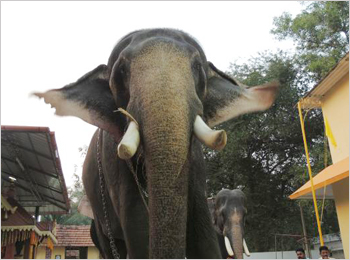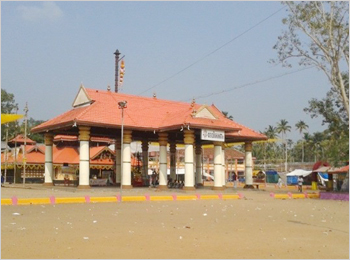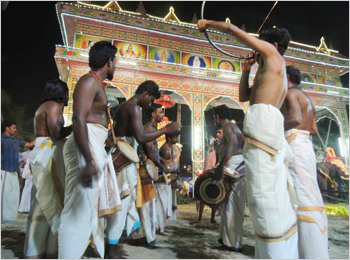Thursday, 16 November 2017
Wednesday, 15 November 2017
Monday, 13 November 2017
Sunday, 12 November 2017
Friday, 10 November 2017
Thursday, 9 November 2017
Velorvattom - Dowloaded
Velorvattom Mahadeva Temple
Overview
Velorvattom is a place near Cherthala, Kerala State, India. The place is famous for a temple "Velorvattom Maha deva temple", dedicated to lord Shiva. The temple has two "nada" (entries) which is uncommon in Kerala. The temple was owned by "Azhvanchery Thamprakkal" and now maintained by Kerala Urazma Devasam Board (KUDB). The temple is believed to be 700 years old. It is believed that the temple was created by Vilwamangalam Swami, a great saint who was a staunch Krishna devotee .
The temple is owned by "Aazvancherry thamprakkal" and now running by Kerala Urazma Devasam Board (KUDB).
The temple is owned by "Aazvancherry thamprakkal" and now running by Kerala Urazma Devasam Board (KUDB).
About the temple

The Temple has two Nadas ,two Dhawjas and Sreekovils in which Lord Shiva resides in two forms which is very rare in Kerala. This temple is one among the 108 temples concecrated by Parasurama in Kerala. This temple is considered to be the MoolaKudumbam of many well known Families in Kerala.
About the Deity

One on the north side known as the Vadakkanappan is considered to be the original pratishta and the pratishta on the south side is a Swayambhoo Vigraham called the Tekkanappan. A Bull is also reared by the authorities in the temple premises as it is considered to be closely related to Lord Shiva. It is believed that Nirmalya Darsanam in Velorvattom Mahadeva temple can lessen our sufferings and bring prosperity to our lifes.
The temple also consists of other Pratishtas namely Mahavishnu, Shasthavu, Ganpathi, Yakshiamma and Naga Pratishta.The Naga Pratishta is given equal importance in this temple. Shivaratri is being celebrated on a grand scale in this tample. An Eight days festival is celebrated in the malayalam month of Kumbham.
The temple also consists of other Pratishtas namely Mahavishnu, Shasthavu, Ganpathi, Yakshiamma and Naga Pratishta.The Naga Pratishta is given equal importance in this temple. Shivaratri is being celebrated on a grand scale in this tample. An Eight days festival is celebrated in the malayalam month of Kumbham.
Festivals

Velorvattom Mahadeva Temple has its annual festival celebrated in the month of feb-March. Among the significant Vazhpadu in this temple include Purakuvilakku, Koovala Mala, Dhara, Sangabhishekam, Mritunjaya Pushpanjali for Lord shiva and PattumManjal and Talichukoda for Naga pratishta. There is also a Vazhipadu named Pitrunamaskaram which is made as an offering to the souls of the ancestors. The temple is conventionally decorated with plantain, coconut leaves, flowers, leaves, traditional lamps and lights. Melam, the panchavadya, a traditional Kerala temple music performance with five instruments, are performed as part of the festival. Traditional performing arts, music and dance are staged during the period.
The festival ends with Arattu. The utsava murti (procession deity) of the deity is taken out of the temple for ritual bathing on the final day. Caparisoned elephants and melam are part of the ritual.
The festival ends with Arattu. The utsava murti (procession deity) of the deity is taken out of the temple for ritual bathing on the final day. Caparisoned elephants and melam are part of the ritual.
Wednesday, 8 November 2017
List of National Symbols of India
List of National Symbols of India

National Bird of India:
The peacock, commomly known as Indian peafowl was declared the national bird of India in 1963, because it was entirely a part of Indian custom and culture. A peacock is a symbol of grace and beauty. Another reason why the peacock was chosen as the national bird was because of its presence across the country, so much so that even common people are familiar with the bird. Moreover, no other country had the peacocok as its national bird either. The peacock fulfilled all these and hence became the national bird of India.

National Animal of India:
The tiger is known as the Lord of the Jungle and displays India’s wildlife wealth. Also strength, agility and power are the basic aspect of the tiger. The Bengal Tiger was declared as the national animal of India in April 1973, with the initiation of Project Tiger, to protect the tigers in India. Prior to this, the lion was the national animal of India.

National Anthem of India:
The national anthem of India is the Hindi version of an anthem which was originally composed in Bengali by Rabindranath Tagore. It was adopted as the national anthem of India on 24 January 1950. Since the Bengali song ‘Vande Mataram’ faced opposition from non-Hindu segments of society, the Jana Gana Mana was adopted as the national anthem of India.

National Flower of India:
The lotus flower has a very significant position in Indian mythology. It is the flower of goddess Laxmi and symbolises wealth, prosperity, and fertility. Also, it grows very uniquely in dirty water with its long stalk far above the water, bearing the flower on the top. The lotus flower remains untouched from impurity. It symbolises purity, achievement, long life, and good fate.

The National Fruit of India: Mangoes are native to India and thus truly Indian. Since time immemorial, mangoes have been cultivated in India. In ancient times as well, deliciousness of mangoes have been defined by many renowned poets. The great Mughal emperor Akbar had planted about 1,00,000 mango trees in Lakhi Bagh in Darbhanga.

The National Song of India:
India’s national song was composed in Sanskrit by Bankimchandra Chatterjee. It has inspired many freedom fighters during the freedom struggle. Initially ‘Vande Mataram’ was the national anthem of India, but after independence ‘Jana Gana Mana’ was adopted as the national anthem. This was done because non-Hindu communities in India had considered Vande Mataram as biased. These communities felt that the nation was represented by ‘Maa Durga’ in the song. So that is why it was made the national song of India and not the national anthem.

National Flag of India:
The national flag of India is horizontal rectangular in shape and has three colours – deep saffron, white and green with Ashoka chakra (Wheel of Law) at its centre. It was adopted on 22 July 1947 during a meeting of the Constituent Assembly. It is also called as tricolor. The flag was designed by Pingali Venkayya.

The National Game of India:
In spite of cricket’s huge popularity in India, hockey is still the national game of India. Hockey when declared as the national game was very popular. The game has seen a golden era during 1928-1956, when India won 6 consecutive gold medals in the Olympics. Hockey was considered as the national game because of its unmatched distinction and incomparable talent at the time. At that time India had played 24 Olympic matches and won all of them.

The National Tree of India:
The Banyan tree represents eternal life, because of its ever-expanding branches. The country’s unity is symbolised by the trees huge structure and its deep roots. The tree is also known as Kalpavriksha, which means ‘wish fulfilling tree’.The Banyan tree is called so, because the Banyan tree has immense medicinal properties and is associated with longevity. The Banyan tree also gives shelter to many different kinds of animals and birds, which represent India and its people from different races, religions and castes.

The National Emblem of India:
The Lion Capital of Ashoka at Sarnath is the national emblem of India. It consists of four Asiatic Lions standing back to back on a circular abacus. The abacus has sculptures of an elephant, a horse, a bull and a lion. These are separated by wheels in between. The national emblem stands on a full bloomed inverted lotus flower.

National River of India:
The Ganges or Ganga is the national river of India. According to the Hindus, this is the most sacred river on the earth. In fact, they perform many rituals on the bank of this river. The Indian cities which are famous for this river are Varanasi, Allahabad and Haridwar. Ganga flows over 2510 km of mountains, plains and valleys, and is the longest river in the country.

National Currency of India:
Indian Rupee is the official currency of the Republic of India. The flow of this currency is controlled by the Reserve Bank of India. The symbol of Indian rupee is derived from the Devanagari consonant “र” (ra). The Indian rupee is named after silver coin, which is called rupiya. It was first issued by Sultan Sher Shah Suri in the 16th century and later the Mughal Empire continued it.

National Heritage Animal of India:
The national heritage animals of India is Elephant. The Indian elephant is a subspecies of the Asian elephant and found in the mainland Asia. It is listed as one of the endangered animals by IUCN. It can be spotted at four different regions in the country.

National Aquatic Animal of India:
The national aquatic animal of India is River Dolphin, which is also called as the Ganges river dolphin. The mammal once used to live in the Ganges, Brahmaputra and Meghna, Kamaphuli and Sangu rivers of India, Bangladesh and Nepal. However, the species is no more found in its early distribution ranges. The river dolphin is essentially blind and lives only in freshwater.

National Reptile of India:
With its length up to 18.5 to 18.8 ft (5.6 to 5.7 m), King Cobra is the national reptile of India. This venomous snake is found in forests in India through Southeast Asia. It preys on other snakes, lizards and rodents. It has its cultural significance as Hindus worship this reptile.
Subscribe to:
Posts (Atom)
Email Samples
Email Samples - http://www.sampleemails.org/ https://www.writeexpress.com/
-
Velorvattom Mahadeva Temple Share: Overview Velorvattom is a place near Cherthala, Kerala...
-
PDF - Tutorials - Click here









